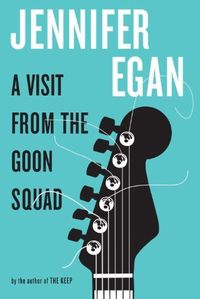Book review Tuesday: A Visit from the Goon Squad, by Jennifer Egan
I had heard a lot of buzz about Jennifer Egan’s book A Visit from the Goon Squad before I read it: it won the Pulitzer Prize for Fiction, it’s being turned into an HBO series, it’s incredible, etc. However, despite all of this buzz, I knew almost nothing about the structure or plot of the book and thus had no idea what to expect when I picked it up a few weeks ago. It can be refreshing to go into a novel blind; often, I read reviews or excerpts or synopses before I dive into a book, and that can interfere with the process of being swept away by a piece of writing. I’m glad I didn’t read much about Egan’s book before starting it; it allowed me to be continually surprised as I read.
A Visit from the Goon Squad is composed of a series of interlocking vignettes, spanning approximately 40 years, featuring characters that are somehow connected to each other (whether they know it or not). The structure is a bit like Love Actually (a movie that I love and that my husband loathes for reasons he can’t articulate, probably because it is, in fact, a good movie), in that the characters from one vignette intersect with the characters from the next, but the novel has a larger temporal and geographic range, spanning decades and continents.
I really enjoyed and was impressed by this book. Egan’s characters are superbly rendered and the dialogue is sharp and witty. The structure of the book, for me, was a tad hit or miss, but mostly a hit. Like any series of vignettes, of course, some worked for me better than others. I particularly loved Chapter 4, “Safari,” which my friend Yohanca informs me has won literary prizes in its own right. I think it helped that I was reading the book while on safari at Elephant Plains, so the descriptions of the bush, the vans, and the lions had a special resonance for me. The chapter is about a record executive, Lou, who is on safari somewhere in East Africa (Kenya, I think) with two of his six children, Rolph and Charlie, and his new, younger girlfriend, Mindy. Accompanying them are: a safari ranger, some assorted band members, and two older women with binoculars who see more than they say. Apart from the lovely, evocative descriptions of the landscape, the animals, and the very feeling of being on safari, this chapter contains razor-sharp observations about relationships, illustrated by the poignant interactions among the characters. In this single chapter, Egan illuminates relationships between siblings, parents and children, boyfriends and girlfriends, acquaintances, and strangers. Here is an excerpt I loved, describing an interaction between Lou’s grad student girlfriend, Mindy, and Albert, the British safari guide, as they sit in the safari van, watching some lions in the bush.
Mindy’s face pounds with blood. Her own window, like Albert’s, is on the jeep’s left side, facing away from the lions. Mindy watches him wet his fingers and snuff out his cigarette. They sit in silence, hands dangling separately from their windows, a warm breeze stirring the hair on their arms, ignoring the most spectacular animal sighting of the safari.
“You’re driving me crazy,” Albert says, very softly. The sound seems to travel out his window and back in through Mindy’s, like one of those whispering tubes. “You must know that.”
“I didn’t,” she murmurs back.
“Well, you are.”
“My hands are tied.”
“Forever?”
She smiles. “Please. An interlude.”
“Then?”
“Grad school. Berkeley.”
Albert chuckles. Mindy isn’t sure what that chuckle means – is it funny that she’s in graduate school, or that Berkeley and Mombasa, where he lives, are irreconcilable locations?
I love Egan’s use of dialogue – spare, not overburdened – to convey both the longing of the characters and the impossibility of their situation. Mindy is with Lou, she and Albert live on different continents, they have different life plans. It just won’t work. We get all of that in that little snippet of dialogue.
At the end of “Safari,” I wanted to know more about these characters, but I only got glimpses of them scattered throughout the later vignettes. This is part of what makes the structure of the novel unsatisfying at times; you want to hear more about certain characters and less about others, but each character only gets his or her own little parcel of the plot.
Egan also experiments with structure in the book by playing with narration (first person, third person, even the elusive second person in Chapter 10, “Out of Body”), and even by presenting one of the chapters in the format of a PowerPoint presentation (I wasn’t a fan). Even though I found the PowerPoint chapter to be trying a bit too hard, I do appreciate Egan’s innovativeness. Also, you have to be impressed with an author who can pull off second person narration so well that you almost forget she’s using second person narration:
You look over at Drew, squinting in the sun, and for a second the future tunnels out and away, some version of ‘you’ at the end of it, looking back. And right then you feel it – what you’ve seen in people’s faces on the street – a swell of movement, like an undertow, rushing you toward something you can’t quite see.
There is much to be said about this novel, and I am probably not doing its complexities justice. Rather than trying to sum up this book of many parts, I recommend just reading it and seeing what you think.

1 Comment-
Pingback: Book review Tuesday: The Interestings, by Meg Wolitzer | Stephanie Early Green